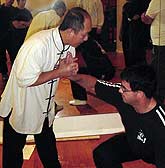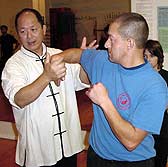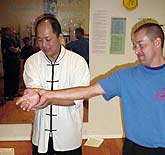Seize the Opportunity with Chin Na: Part 2
By Dr. Yang, Jwing-Ming
 |
Dr, Yang demonstrates a painful
Chin Na grasping and controlling technique during a seminar on this
subject held in Boston. |
Editor’s Note: This is the second
in a two-part article on Chinese Chin Na.
In Part
1 Dr. Yang discussed a number of Chin Na aspects including the need
for speed and power to execute techniques and maintain control, and the
importance of controlling an opponent completely. It Part two Dr. Yang
discusses about how to escape from an opponent’s Chin Na technique
and how to counter Chin Na grabs.
Introduction
Chin Na literally means "seize control." Chin Na covers a wide
range of defensive and offensive techniques, from very fundamental hand
grappling to the very advanced Dim Mak (delayed death touch). The fundamental
techniques can be learned by any martial artist or even by someone without
any martial arts experience. These fundamental techniques can easily be
adapted and incorporated into any martial style such as Judo, Wrestling
(Shuai Jiao), Karate, or Tae Kwon Do to increase the range of responses.
Chin Na Escapes
 |
Dr, Yang demonstrates how to escape
a Chin Na technique as it is being applied. |
A Chin Na expert must also know how to escape from an opponent’s
Chin Na control, and be able to counterattack and reverse the situation.
To escape from an opponent’s control, you must master several techniques
in addition to those explained in the previous section. One of the major
techniques is knowing how to sense the angle at which your opponent is
grabbing, and being able to change the angle so that his control of your
muscles and joints is ineffective. This will give you time to escape.
Of course, often you will be able to escape if you struggle and sweat
a bit. However, for a skillful escape the most important factor is speed,
and the second is skill. Power is not so important in an escape as it
is in offensive Chin Na. Here are a few general ideas on how to escape:
1. Rotation Escape
The main reason for rotation when you are grabbed is to change the angle
of the grab. When your opponent grabs you, he will try to do it at the
most effective angle and location. In order to escape you must act immediately.
If you cannot rotate and change the situation before he has completed
his control, you have lost. It is therefore extremely important to thoroughly
practice escapes both by yourself and with a partner.
When you neutralize an opponent’s grabbing attack, it is important
to remember to neutralize it in such a way that he cannot immediately
continue his attack with another technique. Usually, when you rotate out
of a grab, you will pull your hand back as soon as possible, but while
you do so you must prepare to deal with a possible punch if your opponent
tries to continue his attack.
Solo escape practice is very simple, and you may use almost all of the
escape techniques. You simply use one hand to apply the technique to the
other hand, and practice the escape with the grabbed hand. Solo practice
has the limitation that, since you know and expect the technique, you
cannot build up much sensitivity. It is therefore necessary to also practice
with a partner.
2. Pressure Release Escape
Pressure release escape is the natural reaction of your body to pain.
The principle is very simple. When your opponent tries to control you
with Chin Na, before he completes his control, you simply use your other
hand to grab the opponent’s fingers or hand that is causing you
the pain. This pressure release technique is commonly used in Chin Na
counterattack. In this case, right after you have released the pressure,
immediately change your grab into a Chin Na technique. Therefore, pressure
release escape can be practiced only with a partner.
3. Distraction Escape
Distraction escape is probably the easiest and most effective technique
among the three. Before your opponent has completed his control, you simply
distract his concentration, for example by kicking his shin or groin.
Alternatively, you can use the other hand to punch his nose or poke his
eyes. When his attention is unfocused, you immediately escape from his
grab and, if possible, counterattack with a Chin Na of your own.
Distraction is commonly used both in offense and defense. In offense,
you will often find that your opponent tenses his muscles right after
you grab him. This makes it very hard for you to continue your technique.
When this happens, simply punch or kick him to distract him, and immediately
apply a Chin Na. Remember that Chin Na is effective only when it is a
surprise.
It would be very hard to say which technique is the most effective escape,
because it depends on the situation and the technique being used. It is
impossible to discuss escapes for every situation. However, once you understand
the principles and have practiced a lot with your partners, you will soon
find that escaping is much easier than controlling. Once you thoroughly
understand a Chin Na technique, you should already understand the escape.
Counter Attacks To Chin Na Grabs
 |
Dr, Yang demonstrates an escape
to an opponent’s grab before applying a counter Chin Na technique. |
Generally speaking, it is harder to counterattack against a grabbing
Chin Na than it is to attack with a grabbing Chin Na. This is because
when you attack you make the decision what technique to apply, whereas
when you counterattack you are responding to another person’s attack,
and your actions are determined by, and limited by, the technique he applies.
Therefore, in order to be able to counterattack against a grabbing Chin
Na, you must know what your opponent is doing and what your possible actions
are. Not only that, it normally takes less than one second to apply a
Chin Na, so you have probably one third of that time to react. In order
for you to react naturally and skillfully, your technique must be much
higher than the attacker’s.
There are a few counterattack rules which you should always remember:
1. Always consider escape first and counter second.
You must save yourself first before you can counterattack. It cannot
be denied that sometimes a counterattack is the best way to escape.
However, you should train yourself to escape first, and once you have
developed your reactions enough you will find yourself counterattacking
naturally when it is appropriate.
2. If you are not sure you can use a grabbing Chin
Na for your counterattack, do not use it. Punching or kicking counterattacks
are much easier, faster, and safer than grabbing Chin Na.
3. When you use a counterattack, you must react before
you are completely controlled. You should understand that a perfect
grabbing Chin Na control is very fast and effective when done by a Chin
Na expert. Once you are controlled completely, you will not have any
chance to escape.
4. The crucial key of a successful counterattack is
following the opponent’s motion and then changing the angle. If
you resist at the beginning, you will have set yourself up for your
opponent’s locking. However, if you follow his motion, it will
become difficult for him to lock you in the angle he desires. This will
also provide you an opportunity to change the angle of his locking and
lead him into your trap for your counterattack.
Since there are many possible counter techniques to use against each
grabbing Chin Na, it is impossible to describe all of them. With your
own diligent training, it is quite possible that you will find a counter
for a particular technique which is more effective for you than the ones
described in my Chin Na classes, books and DVDs.
You should realize that usually it is much harder to apply most of the
grabbing Chin Na techniques to an opponent than it is to just punch him
or use a cavity strike Chin Na. However, cavity striking requires a more
thorough knowledge of acupuncture points and understanding of which cavities
are vital at which time of the day. To use a grabbing Chin Na on your
opponent effectively will show him that your fighting ability is much
greater than his. Therefore, if you are not confident that you can handle
your opponent, you should not take a risk and use grabbing Chin Na. Remember:
to show mercy to your opponent means to be cruel to yourself.
When you are in a fight, you should immediately seize your opponent’s
will, confidence, and fighting spirit. This is spiritual Chin Na. This
means that at the beginning of a fight you should use your spirit and
confidence to discourage your opponent and make him lose his fighting
confidence and spirit. Usually, this spirit and confidence is shown on
your face and in the way you look at him. From your eyes and face, your
opponent can sense your spirit of vitality, your courage, your confidence,
your calmness, and subconsciously, even your Qi capacity and will power.
If you can conquer your opponent with this first visual and mental contact,
then you have reached the highest level of Chin Na -- to seize the opponent’s
fighting spirit. Remember: the highest fighting art is to fight without
fighting.
However, if you are not able to discourage him and you must fight, then
you must know a few things. Is your fighting ability greater than his?
Will you be able to use grabbing Chin Na to stop the fight? In order to
use a grabbing Chin Na successfully, you must first test your opponent
and see how his reactions are. This test will reveal his style, and will
let you know whether a grabbing Chin Na will work. Remember: fight smart
and safe, not brave and stupid.
In order for your grabbing Chin Na to be effective, your techniques must
first of all be fast, natural, and skillful. In a fight, everything happens
so fast that you do not have time to think, so your reactions must be
natural. You must therefore train so that your reactions are flexible,
and you can react quickly and correctly to changing situations. Not only
that, you must also know how to fool your opponent and set him up in a
position favorable to your Chin Na application. All of these things must
be trained constantly until they are part of your natural reaction --
only then will you be able to use grabbing Chin Na effectively in a fight.
In addition to the above, there are a number of things you need to train
before you can effectively use grabbing Chin Na in a fight. Since you
opponent will not cooperate with you, it will be quite different from
practicing with a partner. You need to know the ways of setting your opponent
up for your Chin Na control, including an effective intercept of his initial
attack. If you just learn the techniques by rote, and never learn to develop
yourself through your own research, then you should not be called a master
of Chin Na. A master must know how to keep the old and develop the new,
while always following the correct principles and rules.
With more than five thousand years of research and training behind them,
the Chinese martial arts cover a very broad range of techniques, using
the hands, legs, and numerous weapons. The higher levels of Chin Na, which
require the development of Qi and Jin, must be felt, and usually they
can only be learned through oral instruction from a qualified teacher.
If you wish to reach the highest level of skill, but cannot find an instructor,
then you must read, attend seminars, ponder, and practice. If you persevere,
after several years of training you may find yourself at the doorway to
the higher, internal side of the art.
About The Author:
Dr. Yang, Jwing-Ming started his Gongfu (Kung Fu) training at the age
of fifteen under the Shaolin White Crane (Bai He) Master Cheng, Gin Gsao.
In thirteen years of study (1961-1974) under Master Cheng, Dr. Yang became
an expert in the White Crane style of Chinese martial arts, which includes
both the use of bare hands and of various weapons such as saber, staff,
spear, trident, two short rods, and many others. With the same master
he also studied White Crane Chin Na, Tui Na and Dian Xue massages, and
herbal treatment.
At the age of sixteen, Dr. Yang began the study of Taijiquan (Yang Style)
under Master Gao, Tao. After learning from Master Gao, Dr. Yang continued
his study and research of Taijiquan with several masters and senior practitioners
such as Master Li, Mao-Ching and Mr. Wilson Chen in Taipei. Master Li
learned his Taijiquan from the well-known Master Han, Ching-Tang, and
Mr. Chen learned his Taijiquan from Master Chang, Xiang-San. Dr. Yang
has mastered the Taiji barehand sequence, pushing hands, the two-man fighting
sequence, Taiji sword, Taiji saber, and Taiji Qigong.
At 18, he entered Tamkang College in Taipei Xian to study Physics and
also began the study of traditional Shaolin Long Fist (Changquan) with
Master Li, Mao-Ching at the Tamkang College Guoshu Club (1964-1968). He
eventually became an assistant instructor under Master Li. In 1971 he
completed his M.S. degree in Physics at the National Taiwan University
and then served in the Chinese Air Force from 1971 to 1972. In the service,
Dr. Yang taught Physics at the Junior Academy of the Chinese Air Force
while also teaching Wushu. After being honorably discharged in 1972, he
returned to Tamkang College to teach Physics and resumed study under Master
Li, Mao-Ching. From Master Li, Dr. Yang learned Northern style Gongfu,
which includes both barehand techniques, especially kicking, and numerous
weapons.
In 1974, Dr. Yang came to the United States to study Mechanical Engineering
at Purdue University. At the request of a few students, Dr. Yang began
to teach, which resulted in the foundation of the Purdue University Chinese
Kung Fu Research Club in the spring of 1975. While at Purdue, Dr. Yang
also taught college-credited courses in Taijiquan. In May, 1978 he was
awarded a Ph.D. in Mechanical Engineering by Purdue.
Yang's Martial Arts Association was established in Boston, MA in 1982.
Currently, YMAA is an international organization, including 56 schools
in Argentina, Belgium, Canada, Chile, France, Holland, Hungary, Iran,
Ireland, Italy, Poland, Portugal, Spain, South Africa, the United Kingdom,
and the United States. In 1984, Dr. Yang retired from his engineering
career, to focus his energy on teaching and researching the Chinese arts,
and introducing them to the West through many books, videos and DVDs.
Visit http://www.ymaa.com for current information.
Dr. Yang has nearly 40 years of instructional experience: seven years
in Taiwan, five years at Purdue University, two years in Houston, TX,
and 25 years in Boston, MA. On November 29, 2005, Dr. Yang conferred the
title of Taiji Master to one of his senior students, which by definition
bestows the honorable title of Grandmaster upon Dr. Yang.
Dr. Yang is also the founder of the YMAA
Retreat Center in Humbolt County, CA, where he will spend ten years
training a select group of students, starting in August 2008. |